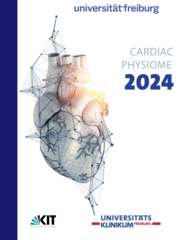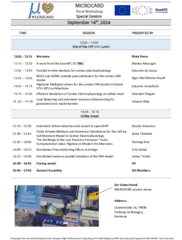Programme
Meeting Venue: Festive Lecture Theatre (Aula), Platz der Universität 3, 79098 Freiburg (map)
| Thursday, 12 September 2024 | ||
| 08:30 – 09:15 | Registration | |
| Session 1: From Structure to Function: Nano Chair: Andrew McCulloch | ||
| 09:15 – 09:30 | Peter Kohl, Axel Loewe, Viviane Timmermann | Cardiac Physiome Workshop 2024: Welcome |
| 09:30 – 10:00 | Eva Rog-Zielinska | 3D time-resolved electron microscopy: a contradiction in terms? |
| 10:00 – 10:15 | Ayako Takeuchi (abstract-selected talk) | Theoretical analyses of the roles of mitochondrial Ca2+ dynamics during exercise using an integrated model of human ventricular myocyte |
| 10:15 – 10:30 | Dennis Ogiermann (abstract-selected talk) | A pressure- and voltage-dependent Piezo ion channel model for cardiomyocytes |
| 10:30 – 10:45 | Susan Chang (abstract-selected talk) | Optogenetic depolarization of fibroblasts prolongs action potentials of cardiomyocytes in murine cryo-ablated heart |
| 10:45 – 11:15 | Coffee break (posters from Session I on display) | |
| Session 2: From Structure to Function: Micro Chair: M Molly Maleckar | ||
| 11:15 – 11:45 | Jan Lebert | Mapping cardiac electrics and mechanics at high spatio-temporal resolution: AI to the rescue? |
| 11:45 – 12:00 | David Nordsletten (abstract-selected talk) | Computational modeling of desmoplakin cardiomyopathy |
| 12:00 – 12:15 | Sridhar Seshan (abstract-selected talk) | Fibroblast mediated dynamics in diffusively uncoupled myocytes |
| 12:15 – 12:30 | Paula Dominguez Gomez (abstract-selected talk) | Validated sex-specific in-silico clinical trials for cardiac safety: assessing drug pro-arrhythmic risk in real-time |
| 12:30 – 14:00 | Lunch (posters from Session I on display) | |
| Session 3: From Structure to Function: Macro Chair: Martyn Nash | ||
| 14:00 – 14:30 | Sandy Engelhardt | Cardiac macroscopy: how to see the wood for all the trees |
| 14:30 – 14:45 | Salla Kim (abstract-selected talk) | Cardiac impact of preterm birth: Insights from modeling |
| 14:45 – 15:00 | Simone Pezzuto (abstract-selected talk) | Reconstruction of the local contractility of the cardiac muscle from deficient apparent kinematics |
| 15:00 – 15:15 | Vladimir Sobota (abstract-selected talk) | Age-associated changes in the apicobasal repolarization gradient affect arrhythmia vulnerability in the human ventricles |
| 15:15 – 15:30 | Hans Dierckx (abstract-selected talk) | Beyond the phase singularity concept: a quasi-particle viewpoint on transient and complex arrhythmia patterns |
| 15:30 – 16:00 | Coffee break (posters from Session I on display) | |
| 16:00 – 16:30 | Michael Gotthardt | From alternative splicing to Frank-Starling: can cardiac mechanics be quantitatively conceptualised bottom-up? |
| 16:30 – 17:00 | Meeting Photo | |
| 17:00 – 19:00 | Poster Session I (posters 1-32) with refreshments, and nibbles, and more… Poster board dimensions (portrait only): 120 cm (47.2") wide x 150 cm (59.0") high. | |
| Friday, 13 September 2024 | ||
| Session 4: Linking Analogue and Digital Worlds - I Chair: Viviane Timmermann | ||
| 09:30 – 10:00 | Daniel Hook | Research data management at the interface between the analogue world and its digital representation: what next? |
| 10:00 – 10:15 | Peter Hunter (abstract-selected talk) | Bond graph protein models for cardiac physiology |
| 10:15 – 10:30 | Janice Reid (abstract-selected talk) | Building a ligand transcriptome encyclopedia for the heart |
| 10:30 – 10:45 | Gregory Sands (abstract-selected talk) | Extended-volume 3D imaging and functional recordings of the human intrinsic cardiac nervous system |
| 10:45 – 11:15 | Coffee break (posters from Session II on display) | |
| Chair: Ayako Takeuchi | ||
| 11:15 – 11:45 | Andrew Taberner | Optimised wet-lab instrumentation for dry-lab research into cardiac structure and function: how to engineer the bi-directional cross-talk between the analogue world and its digital representation |
| 11:45 – 12:00 | Sofia Botti (abstract-selected talk) | In-silico modeling of multi-electrode arrays to enhance cardiac drug testing on heterogeneous hiPSC-CM tissues |
| 12:00 – 12:15 | Nicole Collins (abstract-selected talk) | Myocardial metabolic response to acute ischemia causes mechanical dysfunction following reperfusion |
| 12:15 – 12:30 | Leonardo Sacconi (abstract-selected talk) | Cardiac fibrosis affects electrical conduction and arrhythmogenesis in a pacing-rate-dependent manner |
| 12:30 –14:30 | Poster Session II (posters 33-63) with Lunch Poster board dimensions (portrait only): 120 cm (47.2") wide x 150 cm (59.0") high. | |
| Session 5: Linking Analogue and Digital Worlds - II Chair: Axel Loewe | ||
| 14:30 – 15:00 | Igor Efimov | Real-time arrhythmia detection and termination using ML-based approaches |
| 15:00 – 15:15 | Jairo Rodríguez Padilla (abstract-selected talk) | Model personalization in the infarcted porcine heart: insights from ARI-based action potential calibration |
| 15:15 – 15:30 | Mathias Peirlinck (abstract-selected talk) | Automated cardiovascular material model discovery |
| 15:30 – 15:45 | Mark Potse (abstract-selected talk) | Modeling the heart cell by cell: the MICROCARD project |
| 15:45 – 16:15 | Coffee break (posters from Session II on display) | |
| Chair: Peter Kohl | ||
| 16:15 – 16:45 | Blanca Rodriguez | Modelling drug effects on cardiac function for personalised medicine: hope or hype? |
| 16:45 – 17:30 | Denis Noble | The history of cardiac computational modelling of electrophysiology from relaxation oscillators, to Hodgkin-Huxley, Markov, big data and AI: are we nearly there yet? |
| 18:00 – 00:00 | Meeting Dinner at Peterhofkeller | |
| 18:00 – 18:30 | Reception | Poster Awards Ceremony |
| 18:45 – 21:00 | Meeting Dinner | |
| 21:00 – 00:00 | Entertainment | |
| Saturday, 14 September 2024 | ||
| Session 6: Structure & Function, Analogue & Digital: Going Full Circle Chair: Hermenegild Arevalo | ||
| 09:30 – 10:00 | Natalia Trayanova | Clinical translation of cardiac modeling and image analysis: modelling to the rescue! |
| 10:00 – 10:15 | Laura Bevis (abstract-selected talk) | The production of atrial models at scale: investigating fibres, fibrosis, and the importance of the end-user |
| 10:15 – 10:30 | Mary M Maleckar (abstract-selected talk) | New in-silico models and data-driven methods for valvular heart disease: the first automatic detection pipeline for the mitral valve in cardiac magnetic resonance imaging |
| 10:30 – 11:00 | Coffee break | |
| Chair: Edward Vigmond | ||
| 11:00 – 11:15 | Stephanie Appel (abstract-selected talk) | Roles of stretch-activated channels in atrial fibrillation: from cellular dynamics to whole-heart simulations |
| 11:15 – 11:30 | Tim van Loon (abstract-selected talk) | Accelerated atrial pacing reduces left-heart filling pressure: a combined computational-clinical study |
| 11:30 – 12:00 | Discussion, Participant Feedback, Presentation for 2026 Meeting (at Auckland); Proposals for hosts of 2027 Meeting | |
| 12:00 – 12:15 | Wrap-up | |
After the conclusion of the 2024 Cardiac Physiome Workshop, the final workshop of the MICROcard project will be held as a satellite meeting from 13:00-17:45 at Haus zur Lieben Hand. Download the program here



